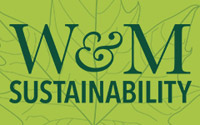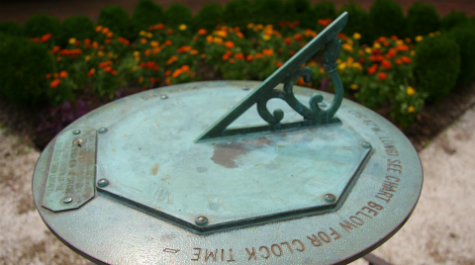New Green to Gold Fund finances larger W&M sustainability projects
When the new LED lights go on in the parking deck this summer, it will represent a signal victory for a new mechanism to fund large-scale sustainability projects at William & Mary.
The green revolving fund, Green to Gold, was founded this spring with an initial pool of $200,000 to finance sustainability projects that reduce resource use or greenhouse gas emissions and that pay for themselves through savings.
Since 2008, William & Mary has collected the annual Green Fee from students to fund small-scale projects through grants that don’t have to be repaid. Usually the projects run from $50 to $24,000.
Surplus funds from the Green Fee provided the seed money for the Green to Gold fund, which will allow the university to tackle larger sustainability projects costing up to $200,000 through loans to various units.
“This initiative is a hallmark of the Committee on Sustainability’s strategy to grow our sustainability effort from the student Green Fee,” said Dennis Taylor, Committee on Sustainability co-chair. “The revolving fund is an important sustainability milestone for William & Mary. With it, we will not only be able to go forward with strategic capital projects that reduce our energy consumption and costs in the long term, but we will also be able to capture savings to grow the fund to levels needed to transform W&M into a fully sustainable institution.”
The first project is a lighting retrofit for the parking garage on Ukrop Way, proposed by Bill Horacio, director of parking services and transportation. Currently, the garage is lit by metal halide and high-pressure sodium lights. When they burn out after two or three years, they scorch the fixtures, meaning the entire assembly has to be replaced at a cost of about $200 each. And the halides are inefficient; only about 24 percent of the energy used goes toward lighting. The rest is lost as heat.
 By retrofitting with LED lights, William & Mary will cut energy use for parking deck lighting by more than 70 percent while providing 33 percent more light in a bulb that lasts 10 to 12 years and doesn’t scorch the fixtures when it dies. The $78,500 project also calls for dropping the lights out of the recessed areas and painting the ceilings white for an overall brighter and safer parking garage.
By retrofitting with LED lights, William & Mary will cut energy use for parking deck lighting by more than 70 percent while providing 33 percent more light in a bulb that lasts 10 to 12 years and doesn’t scorch the fixtures when it dies. The $78,500 project also calls for dropping the lights out of the recessed areas and painting the ceilings white for an overall brighter and safer parking garage.
Based on the estimated savings, parking services should pay back the Green to Gold Fund within three years. Without the loan, Horacio said parking services would have had to raise the price of parking decals and passes.
“Nobody would dispute the benefits of a more than 20 percent return on investment, a 70 percent reduction in energy and something that produces better light,” said Henry Broaddus, vice president for strategic initiatives and public affairs. “You get a better product, lower demand on energy consumption and a huge return on investment. The provost has referred to this as ‘alchemy.’ You shouldn’t be able to have all of those. But absent the revolving fund, there is no mechanism for an auxiliary service to have the cash on hand.”
The Green to Gold fund found its start in an article Sustainability Director Calandra Waters Lake found in the New York Times outlining green revolving funds as an emerging trend in sustainability finance. She sent it to the Committee on Sustainability, and Broaddus, a committee member, encouraged her to research it further.
She did, investigating all of the ways corporations and institutions structure and use green revolving funds to pay for large-scale capital projects, presenting her findings to the Business Innovation Committee.
A charter was written and the Green to Gold Fund Committee was formed by role, not by person, incorporating key personnel in facilities, auxiliary services and finance, plus student representatives. It includes Broaddus as chair; Waters Lake; Committee on Sustainability co-chairs Lynda Butler and Dennis Taylor; VIMS Professor Deborah Bronk; Van Dobson, associate vice president of facilities management; undergraduate student Juliet Downie ’17; Auxiliary Services Director Cindy Glavas; undergraduate student Zhuowei Huang ’18; Dennis Manos, vice provost for research and graduate professional studies and Chief Financial Officer Amy Sebring.
The committee issued a call for proposals, which can be submitted by students, faculty or staff. The committee has built some reinvestment opportunities into the fund, so it is expected to grow over time, but Waters Lake said that they have also been working with Robert Waggoner in the Office of University Advancement on potential ways to reach donors who are moved by either the environmental benefits or by the idea that their donation will be used to increase efficiency on campus.
“This makes people who might not be that interested in greenhouse gas emissions or resource use pay attention, because the return on investment with these projects tends to be high. It’s higher than on a lot of other investments,” Waters Lake said. “Historically, we see the environment and the economy go head-to-head, but in reality we’re seeing more of a marriage of the two.”
Broaddus quotes the old parable about the young girl walking hand-in-hand with her grandfather when she spies a $20 bill on the sidewalk. She asks if she can grab it and the grandfather, wise in the ways of the world, tells her not to bother. “If it was a real $20 bill,” he says, “someone else would have already picked it up.”
The story inspires Broaddus’ economic development and business innovation office, he said.
“What’s exciting about business innovation generally is that we’re starting out with the premise that there are actually a lot of $20 bills on the brick paths around campus,” Broaddus said. “Where the opportunity for savings can also contribute to doing our jobs better, seeing more effective outcomes and improving sustainability, it’s a triple-win. This fund has enormous potential for that.”














